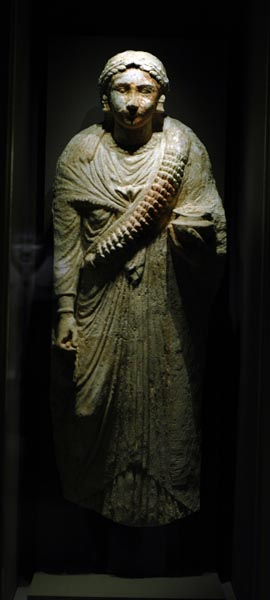
The hair, dress, and jewellery of the unidentified woman' are typical of wealthy matrons of Roman Egypt. Her earrings are of the bar pendant variety, one of three styles that Petrie identified from the mummy portraits he discovered at Hawara.' This three-pearl style usually accompanied "overloaded necklaces"9 and, although changes in earring styles were not strictly chronological, this bar-pendant style is seen on portraits of women into the fourth century AD 11
Although the long, knotted gown has been seen to identify its wearer as a priestess of the goddess Isis," there is no identifying inscription or other evidence. A thick funerary wreath drapes diagonally from the left shoulder, across the torso. It is paralleled by A sash decorated with various crown, star, and moon motifs worn by a headless statue in the Berlin Museum." The men depicted in these stelae usually carry a garland of similar type in one hand (for the significance of funerary wreaths and crowns).
The woman's left arm is crooked at the elbow and her left hand is held close to her body. In her left hand, she holds a vessel, perhaps "a small bowl full of sacred Nile water," although the more common attribute is a container for incense." Her right arm hangs down at her side. Her right hand "may have held a sistrum or rattle"" (of three inscribed Ptolemaic statues of women wearing this tripartite garment, "all three bear the title ihyt, "player of the sistrum"). In other examples, the right hand holds a pellet of incense about to be placed upon an altar."
Oxyrhynchus has provided us with some of the earliest literary evidence for Christianity in Upper Egypt, yet these niched funerary stela with eastern Mediterranean influences.
Source: Mummies and Magic, the Funerary arts of Ancient Egypt; Museum of Fine Arts Boston